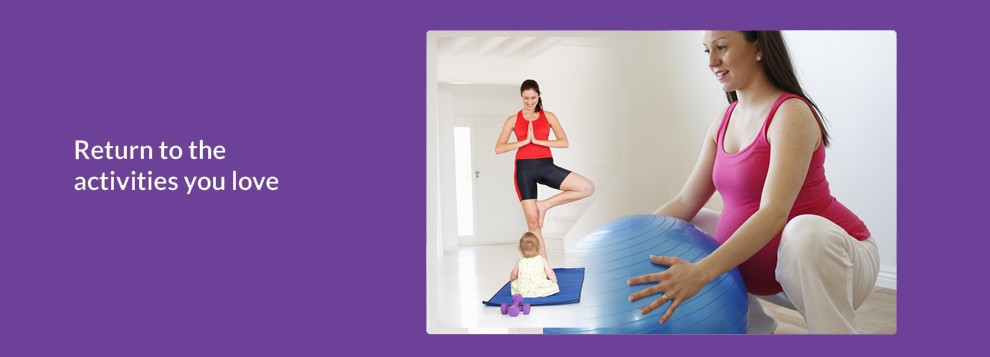Urinary Incontinence Physiotherapy:
 Dribbling or leaking, even if only when you jump, run or cough is not normal, EVER! Julia Di Paolo, a Pelvic Floor Physiotherapist certified in Pfilates, has worked extensively with Kim Vopni of Pelvic Floor Wellness (http://www.pelvicfloorwellness.com) and has years of experience designing exercise programs for women of all ages who are experiencing varying levels of incontinence. From the menopausal woman who only leaks a few drops when she runs, to the new moms who empty their bladder every time they sit upright.
Dribbling or leaking, even if only when you jump, run or cough is not normal, EVER! Julia Di Paolo, a Pelvic Floor Physiotherapist certified in Pfilates, has worked extensively with Kim Vopni of Pelvic Floor Wellness (http://www.pelvicfloorwellness.com) and has years of experience designing exercise programs for women of all ages who are experiencing varying levels of incontinence. From the menopausal woman who only leaks a few drops when she runs, to the new moms who empty their bladder every time they sit upright.
If you have just had a baby or are going through menopause, we will design an exercise program specific to your needs that will work for you. The program is “more than just Kegels”. You will strengthen your pelvic floor muscles and your core, safely and progressively going from rehab to performance.
At PhysioExcellence in downtown Toronto, treatment is based on the type of incontinence you have. It is very important to be assessed correctly so that the exercises you are doing are appropriate and helpful. Just doing “kegels” is often not enough. The pelvic floor muscles must be retrained to contract voluntarily (waiting till you get the bathroom to pee) and involuntarily (during a cough). The right combination of strength, endurance, relaxation and control of these muscles is vital. Behaviour modification may also be used to establish proper voiding habits. Continence is maintained by the synergy of the support structures of the pelvic floor: pelvis, pelvic floor muscles, and also the connective tissue and myofascial system.
Pelvic Floor Physiotherapy includes:
• Internal vaginal/anal examination of the pelvic floor muscles, joints, nerves and myofascial
systems in the pelvis
• Trigger point release
• Myofascial release
• Muscle re-education and re-patterning
• Biofeedback
• Education
• Lifestyle changes/behavior modification
• Home exercise program
What is urinary incontinence?
 Urinary incontinence (UI) is the inability to control urination. It is the involuntary loss of urine at anytime and of any amount. The severity of urinary incontinence ranges from occasionally leaking urine when you cough or sneeze to having an urge to urinate that's so sudden and strong you don't get to a toilet in time. Following vaginal childbirth the risk of stress urinary incontinence is 23%, the risk of urge urinary incontinence is 12%, and the risk of any urinary incontinence is 29%. This increases to 34% for new moms over 30 years of age.
Urinary incontinence (UI) is the inability to control urination. It is the involuntary loss of urine at anytime and of any amount. The severity of urinary incontinence ranges from occasionally leaking urine when you cough or sneeze to having an urge to urinate that's so sudden and strong you don't get to a toilet in time. Following vaginal childbirth the risk of stress urinary incontinence is 23%, the risk of urge urinary incontinence is 12%, and the risk of any urinary incontinence is 29%. This increases to 34% for new moms over 30 years of age.
There are 5 types of urinary incontinence:
- Urge Incontinence
- A sudden and uncontrollable need to urinate
- This person is unable to put off urinating until later
- There is a large amount of urine that is leaked
- Stress or Effort Incontinence
- Involuntary loss of urine during activity such as coughing, sneezing, laughing, jumping or running
- Small loss of urine leaked
- Mixed Incontinence
- A mix of stress incontinence and urge incontinence
- A mix of stress incontinence and urge incontinence
- Functional Incontinence
- Loss of urine associated with an inability to get to a toilet in time
- Can be cognitive (dementia, Alzheimer’s), physical (arthritis-decreased mobility), psychological or environmental
- Overflow Incontinence
- Constant loss of a small quantity of urine
- Unable to fully empty bladder
- Residual volume of urine remains in bladder distending it
Risk factors for incontinence include:
- Female
- Post menopause
- Multiple urinary tract infections (UTI)
- Gynecological or urinary surgeries
- Chronic disease
- Medication
- Multiparity






